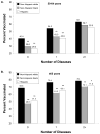Disparities in influenza vaccine coverage in the United States, 2008
- PMID: 20533970
- PMCID: PMC3249761
- DOI: 10.1111/j.1532-5415.2010.02904.x
Disparities in influenza vaccine coverage in the United States, 2008
Abstract
Objectives: To determine the distribution of influenza vaccine coverage in the United States in 2008.
Design: Cross-sectional analysis.
Setting: The 2008 Behavioral Risk Factor Surveillance Survey, which employs random-digit dialing to interview noninstitutionalized adults in the United States and territories.
Participants: Two hundred forty-nine thousand seven hundred twenty-three persons aged 50 and older.
Measurements: Participants were asked whether they had had an influenza vaccination during the previous 12 months.
Results: In 2008, 42.0% of adults aged 50 to 64 and 69.5% of adults aged 65 and older reported receiving an influenza vaccination in the past 12 months. Vaccine coverage generally increased with advancing age (P<.001), higher levels of education (P<.001) and total household income (P<.001), and greater morbidity (P<.001). In participants aged 50 to 64, vaccine prevalence was lower in men (39.9%) than in women (44.1%; P<.001), although no significant differences were observed in older adults. Within each 5-year interval of age, non-Hispanic blacks and Hispanics had significantly lower vaccine prevalence than non-Hispanic whites (P<.001 for all comparisons). For participants aged 65 and older, non-Hispanic blacks and Hispanics were 56% (adjusted prevalence ratio (PR)=1.56, 95% confidence interval (CI)=1.48, 1.64) and 44% (adjusted PR=1.44, 95% CI=1.35, 1.54) more likely, respectively, to be unvaccinated than non-Hispanic whites, adjusting for age and sex. Racial and ethnic disparities in vaccine coverage narrowed with increasing number of diseases, although these disparities remained significant in older adults with two or more diseases (P<.05).
Conclusion: There were large disparities in influenza vaccine coverage in 2008, particularly across race and ethnicity and socioeconomic position. Accordingly, more targeted interventions are needed to improve vaccine delivery to disadvantaged segments of the U.S. population.
Conflict of interest statement
[Table: see text]
Figures
Similar articles
-
Racial and Ethnic Disparities in Influenza Vaccination among Adults with Chronic Medical Conditions Vary by Age in the United States.PLoS One. 2017 Jan 12;12(1):e0169679. doi: 10.1371/journal.pone.0169679. eCollection 2017. PLoS One. 2017. PMID: 28081234 Free PMC article.
-
Racial and Ethnic Disparities in Vaccination Coverage Among Adult Populations in the U.S.Am J Prev Med. 2015 Dec;49(6 Suppl 4):S412-25. doi: 10.1016/j.amepre.2015.03.005. Epub 2015 Aug 18. Am J Prev Med. 2015. PMID: 26297451 Free PMC article.
-
Factors associated with vaccination of medicare beneficiaries in five U.S. communities: Results from the racial and ethnic adult disparities in immunization initiative survey, 2003.J Am Geriatr Soc. 2006 Feb;54(2):303-10. doi: 10.1111/j.1532-5415.2005.00585.x. J Am Geriatr Soc. 2006. PMID: 16460383
-
Trends in racial/ethnic disparities in influenza vaccination coverage among adults during the 2007-08 through 2011-12 seasons.Am J Infect Control. 2014 Jul;42(7):763-9. doi: 10.1016/j.ajic.2014.03.021. Epub 2014 May 3. Am J Infect Control. 2014. PMID: 24799120 Free PMC article.
-
Influenza vaccination among cancer survivors: disparities in prevalence between blacks and whites.J Cancer Surviv. 2013 Jun;7(2):183-90. doi: 10.1007/s11764-012-0257-3. Epub 2013 Jan 13. J Cancer Surviv. 2013. PMID: 23315210 Free PMC article.
Cited by
-
Health inequities in influenza transmission and surveillance.PLoS Comput Biol. 2021 Mar 11;17(3):e1008642. doi: 10.1371/journal.pcbi.1008642. eCollection 2021 Mar. PLoS Comput Biol. 2021. PMID: 33705381 Free PMC article.
-
Racial and ethnic disparities in uptake and location of vaccination for 2009-H1N1 and seasonal influenza.Am J Public Health. 2011 Jul;101(7):1252-5. doi: 10.2105/AJPH.2011.300133. Epub 2011 May 12. Am J Public Health. 2011. PMID: 21566026 Free PMC article.
-
Determinants of non-vaccination against seasonal influenza in Canadian adults: findings from the 2015-2016 Influenza Immunization Coverage Survey.Can J Public Health. 2018 Jun;109(3):369-378. doi: 10.17269/s41997-018-0018-9. Epub 2018 Mar 30. Can J Public Health. 2018. PMID: 29981075 Free PMC article.
-
Confidence in social institutions, perceived vulnerability and the adoption of recommended protective behaviors in Brazil during the COVID-19 pandemic.Soc Sci Med. 2020 Nov;265:113477. doi: 10.1016/j.socscimed.2020.113477. Epub 2020 Oct 27. Soc Sci Med. 2020. PMID: 33190926 Free PMC article.
-
Influenza vaccination in patients with diabetes: disparities in prevalence between African Americans and Whites.Pharm Pract (Granada). 2014 Apr;12(2):410. doi: 10.4321/s1886-36552014000200008. Epub 2014 Mar 15. Pharm Pract (Granada). 2014. PMID: 25035719 Free PMC article.
References
-
- Antunes JLF, Waldman EA, Borrel C, et al. Effectiveness of influenza vaccination and its impact on health inequalities. Int J Epidemiol. 2007;36:1319–26. - PubMed
-
- Nichol KL, Nordin JD, Nelson DB, et al. Effectiveness of influenza vaccine in the community-dwelling elderly. N Eng J Med. 2007;357:1273–81. - PubMed
-
- Thompson WW, Shay DK, Weintraub E, et al. Mortality associated with influenza and respiratory syncytial virus in the United States. JAMA. 2003;289:179–86. - PubMed
-
- Nelson JC, Jackson ML, Weiss NS, et al. New strategies are needed to improve the accuracy of influenza vaccine effectiveness estimates among seniors. J Clin Epidemiol. 2009;62:687–94. - PubMed
-
- Fiore AE, Shay DK, Broder K, et al. Centers for Disease Control and Prevention (CDC); Advisory Committee on Immunization Practices (ACIP) Prevention and control of influenza: Recommendations of the ACIP, 2008. MMWR Recomm Rep. 2008;57:1–60. - PubMed
Publication types
MeSH terms
Substances
Grants and funding
LinkOut - more resources
Full Text Sources
Medical
Research Materials
Miscellaneous


